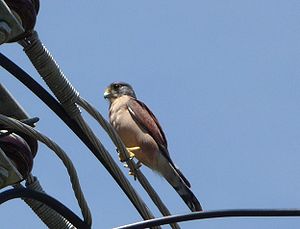Seychelles falcon
| Seychelles falcon | ||||||||||||
|---|---|---|---|---|---|---|---|---|---|---|---|---|

Seychelles falcon ( Falco araea ) |
||||||||||||
| Systematics | ||||||||||||
|
||||||||||||
| Scientific name | ||||||||||||
| Falco araea | ||||||||||||
| ( Oberholser , 1917) |
The Seychelles falcon ( Falco araea ), also known as the Seychelles kestrel , is a small, slender bird belonging to the genus of falcons . It is endemic to the Seychelles .
features
With a size of 15 to 24 centimeters, the Seychelles falcon is the smallest representative of the real falcon . The wing span is 44 to 47 centimeters and the tail length 11 to 12 centimeters. The males reach an average weight of 73 grams. The females are a little heavier at 87 grams. The back and wings of the male adult bird are spotted maroon and black. The head and rump are dark gray. A short streak of beard can be seen on the chin. The medium-long, gray tail has four thin black bands. The subterminal band shows a whitish tip. The underside is beige-pink. The throat and tail are whiter. In flight, the body and underwing-coverts are beige-pink. The under tail-coverts, the grayish hand-wings and the pink-tinted arm-wings are banded dark. The head, rump and top of the tail are gray. The back and wings are maroon. The wings of the hand are dark brown. The plumage of the female is lighter. The young birds differ from the adult birds in their chestnut-brown vertex, the lighter face, the stronger markings and the reddish tinted beige tail. The underside is reddish beige with a sparse pattern of spots. The throat and tail are cream-colored. The contact call during the breeding season consists of a loud ki-ki-ki .
Occurrence
The Seychelles falcon is found on Mahé , Silhouette , Praslin and North Island . Stray visitors have occasionally been seen on La Digue . It is extinct on Curieuse , Félicité , Marianne , Sainte Anne , Cerf Island , Longue , Thérèse , Grande Sœur and Petite Sœur .
habitat
The Seychelles falcon inhabits dense secondary forests, rocky highlands, open terrain, coconut plantations, gardens and cities. It can be found at altitudes of up to 900 meters.
Way of life
The main food of the Seychelles falcon consists of lizards, especially skinks of the genus Mabuya and day geckos . Other foods include insects, small birds, and mice. The Seychelles falcon is an open hide hunter. Poles, trees, rocks or buildings are used as sitting areas. The attacks on its prey are carried out by rapid, whirring wing beats and by gliding.
The breeding season extends from August to October. Nests are made in hollows, mainly on rock walls more than 200 meters above the ground, but also in abandoned shepherd's main nests in coconut palms and in the cornices of buildings or in tree hollows. The two to three eggs are hatched in 28 to 31 days. The young are fledged after 35 to 42 days. The boys remain in their parents' territory for a further 9 to 24 weeks.
Existence and endangerment
Until 1939 the Seychelles falcon was still widespread on almost all of the Seychelles' islands. In 1965 fewer than 30 copies were counted on Mahé. However, in subsequent studies between 1972 and 1973, a population of 49 pairs was found. Since 1976 the population on Mahé has been stable at 370 pairs. There are also 10 pairs on Silhouette and North and four pairs on Praslin. In the past, the Seychelles falcon was pursued as a messenger of bad luck and a supposed chicken hunter. However, since the 1960s , the pesticides used in the cinnamon plantations have been responsible for its decline. Other threats are posed by food competition from introduced barn owls , chicks being stalked by rats, fires and the development of housing developments in urban areas. The IUCN classifies the species as endangered (vulnerable).
literature
- James Ferguson-Lees & David A. Christie 2001: Raptors of the World . Houghton Mifflin, Boston. ISBN 0-618-12762-3
- James Ferguson-Lees & David A. Christie: The birds of prey of the world (German by Dr. Volker Dierschke and Dr. Jochen Dierschke). Franckh-Kosmos-Verlags-GmbH & Co. KG. Stuttgart, 2009. ISBN 978-3-440-11509-1
- Josep del Hoyo , Andrew Elliott & Jordi Sargatal (eds.): Handbook of the Birds of the World. Volume 2: New World Vultures to Guineafowl. Lynx Edicions, Barcelona 1994, ISBN 84-87334-15-6 .
- Warren B. King on the behalf of the International council for bird preservation (ICBP) and the Survival service commission of IUCN (1978-1979): Red Data Book 2: Aves (2nd edition). IUCN, Morges, Switzerland. 1981. ISBN 0-87474-583-7
- Malcolm Penny : The Birds of the Seychelles and the Outlying Islands , Collins, London 1974, ISBN 0-00-216060-9
Web links
- The Peregrine Fund - Global Raptor Information Network - Seychelles Kestrel
- ARKive - Pictures and informations about Falco araea
- Nature Seychelles - Seychelles Kestrel
- BirdLife Species factsheet
- Videos, photos and sound recordings of Falco araea in the Internet Bird Collection
- Falco araeus inthe IUCN 2013 Red List of Threatened Species . Listed by: BirdLife International, 2012. Retrieved October 2, 2013.